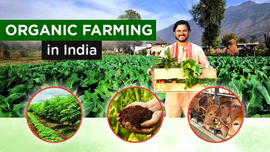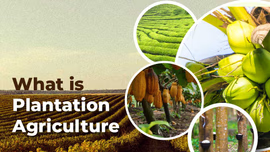What are Carbon Credits: Key Schemes, Benefits for Farmers, Challenges

India is focusing on the development of a greener, more sustainable future. Towards this end, carbon credits have paved the way for reducing greenhouse gas emissions. Both farmers and private companies are key stakeholders in the carbon market. This blog explores the policies that support carbon credits in India, their benefits for farmers and future prospects for the carbon market of the country.
Table of Contents
- Introduction to the Carbon Market
- What is Carbon Farming?
- What are the Primary Agriculture Practices for Carbon Credits?
- Government Initiatives to Support the Carbon Market
- Benefits of Carbon Credits
- What are the Challenges and Future of Carbon Credits?
Introduction to the Carbon Market
India is known to have one of the largest agricultural sectors globally being the leading producer of pulses, milk, wheat, rice, jute, sugarcane, etc. However, several challenges related to increasing productivity, natural resource depletion, and climate change plague Indian agriculture. Also, it contributes around 14% of greenhouse gas (GHGs) emissions across the country. Using sustainable practices can allow the agriculture sector to act as a significant carbon sink.
Since the 1980s, private companies have been taking up carbon projects to offset their carbon emissions. The carbon market in India is functioning under compliance markets, involving Perform Achieve and Trade (PAT) and Renewable Energy Certificates (REC), as well as voluntary (offset) projects like the Clean Development Mechanism (CDM). In terms of registered CDM projects, Indian agencies are in second place globally. Also, over 106 million tonnes of CO2 emissions have been saved between 2015 and June 2024 under the PAT scheme.
The Voluntary Carbon Market (VCM) allows companies to buy and sell carbon credits, which are usually translated from emission reductions. It is usually practiced to fulfil their CSR and sustainability goals. Carbon trading is integral to the agriculture sector as farming operations have huge potential to emit and sequester carbon.
What is Carbon Farming?
Carbon farming involves an agricultural management system or sustainable agricultural practices aimed to allow soil and vegetation to store more carbon while reducing GHG emissions. Its key practices not only increase the organic carbon content of soil and reduce methane & nitrous oxide emissions but also promote biodiversity. Some of the most beneficial carbon-sequestering practices include agroforestry, conservation tillage, cover cropping, crop rotation, improved livestock management, and organic compost. Along with storing carbon, adopting these methods also improves water retention and enhances soil health and tolerance to climate variability.
What are Carbon Credits?
Carbon credits or carbon allowances enable companies or other stakeholders to certain a specific amount of GHGs, including carbon dioxide. 1 carbon credit equals one ton of CO2 emissions removed from the atmosphere. From the business perspective, it permits the emission of one ton of carbon dioxide. Farmers can adopt sustainable practices for lowering emissions or sequestering carbon to generate these credits. It provides farmers with additional income while ensuring sustainable agriculture and a cleaner environment. Also, companies purchase carbon credits to fulfil their compliance obligations. Carbon credits are traded in a marketplace known as a carbon market.
What are the Primary Agriculture Practices for Carbon Credits?
The generation of carbon credit is supported by different certification standards, like the Gold Standard and Verra’s Verified Carbon Standard (VCS). There are many sustainable agriculture practices related to carbon farming:
- Soil carbon sequestration removes CO2 from the atmosphere and transfers it into the soil in the form of organic carbon. Soil carbon storage can be increased by techniques such as crop rotation and no-till farming. Carbon credits are created through improved ecosystem services and soil quality.
- Efficient irrigation techniques like sprinkler irrigation and drip systems decrease the wastage of water. It results in lowered energy requirements and subsequent lower emissions.
- Methane emissions can be reduced in rice farming and livestock through improved rice field water management and manure handling.
- Agroforestry is an effective land management system integrating shrubs and trees with farmland. It improves carbon sequestration in soil and biomass, assisting in the mitigation of climate change.
Government Initiatives to Support the Carbon Market
The majority of VCM projects in India are enrolled in global registry like Gold Standard and Verra. In 2022, the Energy Conservation (Amendment) Bill was introduced to develop the compliance carbon market of the country. Some key initiatives associated with carbon credits are:
Carbon Credit Trading Scheme (CCTS)
In 2023, the Carbon Credit Trading Scheme (CCTS) was notified by the government ensuring the establishment of a carbon credit market in India. As per the scheme, ‘Accredited Carbon Verifier’ falls under the Bureau of Energy Efficiency (BEE). This agency validates or verifies as per the CCTS. This scheme provides the Carbon Credit Certificate to the registered entity. A single certificate indicates the reduction/removal of 1 ton of CO2 equivalent. The Indian Carbon Market (ICM) is to be monitored by the Indian Carbon Market Governing Board (ICMGB).
Green Credit Program (GCP)
Under the Environment Protection Act 1986, the government notified the Green Credit Rules, 2023, to address positive environmental actions and issue environmental rewards to entities in the form of Green Credits (GCs). Some of the major activities under the Green Credit Program are:
- Sustainable building and infrastructure
- Ecomark label development
- Mangrove conservation and restoration
- Air pollution reduction
- Waste management
- Sustainable agriculture
- Water management
- Tree plantation
Framework for Voluntary Carbon Market
In 2024, the government launched the Framework for Voluntary Carbon Market in Agriculture Sector & Accreditation Protocol of Agroforestry Nurseries. The main goal of the VCM framework is to develop awareness and capacity-building of all stakeholders. It also aims to encourage farmers to take up sustainable agricultural practices. This framework would develop a market-based mechanism to reward sustainable agricultural practices.
Benefits of Carbon Credits
- A small farmer can use carbon credits as a unique opportunity for income source diversification. It allows them to invest in top-quality equipment, seeds, and resources.
- Due to the additional income stream, farmers can depend less on market fluctuations and seasonal harvests. This financial stability is highly critical for marginal farmers.
- Soil fertility can be improved along with water retention through techniques such as conservation agriculture and agroforestry. It can also result in higher crop yields.
- By adopting sustainable agricultural practices to generate carbon credits, their fields become more resilient to floods, droughts, and other climate change impacts.
What are the Challenges and Future of Carbon Credits?
One of the major challenges is measurement and verification complexity, as advanced monitoring tools are required for assessing carbon credits. There is a big technological gap that needs to be addressed by the government.
There is a lack of awareness due to which a majority of Indian farmers do not have much knowledge about carbon credit markets. Most Indian farmers have fragmented landholding, due to which there is less scope for economies of scale in carbon farming.
Carbon markets are still in their growth phase, so there is a risk of volatility. Also, there is a need for a much clearer regulatory and policy landscape. A solid carbon trading framework needs to be established for effective participation.
So, the way forward is to address these issues with the help of strategic measures like technological advancements, capacity building, financial incentives, and policy refinement. India has a big potential to lead the global carbon market by focusing on industry participation and promoting international collaboration. India needs to develop a robust and reliable carbon market that aligns with the climate goals and facilitates sustainable development.


Related Blogs












